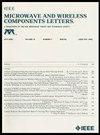基于先进130纳米BiCMOS技术的220 - 320 ghz j波段4路功率放大器
IF 3.3
2区 工程技术
Q2 ENGINEERING, ELECTRICAL & ELECTRONIC
引用次数: 5
摘要
提出了一种基于130纳米BiCMOS技术的J波段(220 ~ 320 GHz)功率组合宽带功率放大器(PA)。输入功率由两个级联的1对2功率分配器分割,中间有放大级。四个分裂信号驱动四个输出级,它们的输出组合在一个4路零度组合器内。拆分和合并网络还包含阻抗匹配。在去嵌入每侧损耗为2db的I/O垫和平衡后,PA在频带中部获得20db增益,在320ghz时获得最小17db增益,I/O回波损耗低于- 5db。PA记录的饱和输出功率范围为9.5至14.5 dBm,横跨J波段。它从3v电源消耗710 mW,对应于270 GHz的漏极效率($\eta _{d}$)为3.15%。与目前最先进的200 GHz以上的硅基放大器相比,该放大器实现了两倍的带宽和1.5倍的性能。据作者所知,这是第一个涵盖硅技术整个J$ $波段的PA。本文章由计算机程序翻译,如有差异,请以英文原文为准。
220–320-GHz J-Band 4-Way Power Amplifier in Advanced 130-nm BiCMOS Technology
A power combined wideband power amplifier (PA) covering the $J$ -band (220–320 GHz) is presented in 130-nm BiCMOS technology. The input power is split by two cascaded 1-to-2 power splitters with amplification stages in-between. The four split signals drive four output stages, which have their outputs combined within a 4-way zero-degree combiner. The splitting and combining networks also incorporate impedance matching. After de-embedding the I/O pads and baluns of 2 dB loss at each side, the PA achieves a gain of 20 dB at the middle of the band and a minimum gain of 17 dB at 320 GHz with I/O return losses below −5 dB. The PA records a saturated output power ranging from 9.5 to 14.5 dBm across the $J$ -band. It consumes 710 mW from a 3 V supply which corresponds to a drain efficiency ( $\eta _{d}$ ) of 3.15% at 270 GHz. The presented PA achieves twice better bandwidth with 1.5 times better $\eta _{d}$ than the state-of-the-art silicon-based amplifiers above 200 GHz. To the authors’ knowledge, this is the first PA covering the whole $J$ -band in silicon technologies.
求助全文
通过发布文献求助,成功后即可免费获取论文全文。
去求助
来源期刊

IEEE Microwave and Wireless Components Letters
工程技术-工程:电子与电气
自引率
13.30%
发文量
376
审稿时长
3.0 months
期刊介绍:
The IEEE Microwave and Wireless Components Letters (MWCL) publishes four-page papers (3 pages of text + up to 1 page of references) that focus on microwave theory, techniques and applications as they relate to components, devices, circuits, biological effects, and systems involving the generation, modulation, demodulation, control, transmission, and detection of microwave signals. This includes scientific, technical, medical and industrial activities. Microwave theory and techniques relates to electromagnetic waves in the frequency range of a few MHz and a THz; other spectral regions and wave types are included within the scope of the MWCL whenever basic microwave theory and techniques can yield useful results. Generally, this occurs in the theory of wave propagation in structures with dimensions comparable to a wavelength, and in the related techniques for analysis and design.
 求助内容:
求助内容: 应助结果提醒方式:
应助结果提醒方式:


